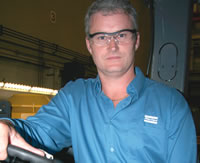 Atlas Copco’s cutting-edge automation technology is gaining traction in the mining industry. Introduced in 1998, the company’s Rig Control System (RCS) was slow to gain acceptance. Drillers were uncomfortable with it, and mining companies took the more conservative approach of sticking with proven technology.
Atlas Copco’s cutting-edge automation technology is gaining traction in the mining industry. Introduced in 1998, the company’s Rig Control System (RCS) was slow to gain acceptance. Drillers were uncomfortable with it, and mining companies took the more conservative approach of sticking with proven technology.
But the tide began to turn in 2006, claims Sudbury-based Blaine Vatcher, Atlas Copco product manager for tunneling and mining equipment. In 1998, Atlas Copco had one RCS rig in Canada. By 2006, there were 17 and, this year, there will be more than 60.
Based on CANbus technology, the Rig Control System automates drilling and provides operators and maintenance supervisors with advanced diagnostics.
The Rig Control System monitors equipment performance, logs information and displays error messages in plain English on a dashboard display.
The operator can override a warning if it’s not too critical, or he can talk it over with a maintenance technician.
The system pinpoints the source of the problem, allowing the service technician to collect any necessary parts and get the machine back in production with minimal downtime.
“The technician is led to the issue rather than having to troubleshoot the entire machine,” said Vatcher.
Nickel Rim
Xstrata Nickel recently purchased a fleet of Atlas Copco jumbos and production drills with Rig Control System technology for its new Nickel Rim South Mine in Sudbury.
“Each machine is like another computer on their network,” said Vatcher. “It could be wireless or wired. It’s up to the customer, but at Nickel Rim South, it’s wireless. They’re putting in a backbone and wireless network system, so they can talk to their machines.”
In the event of a warning, an operator can call and ask his supervisor on surface to pull up the machine on his computer.
“He’ll say, ‘Ya, you can bypass that,’ or ‘I’ll send the mechanic down.’”
RCS technology on Atlas Copco drill rigs can automate drilling based on a geologist’s drill pattern downloaded from the network or saved on a PCMCIA card inserted into the machine’s onboard computer.
There are several levels of RCS automation available.
With RCS Total, the operator pulls the machine into a drift, navigates it so it knows where it is in the mine and watches it drill the perfect drill pattern.
Rather than just sit there with nothing to do, operators will often take control of one boom and let the Rig Control System look after the other one. Operator oversight is still critical “because there could be interference from a bolt sticking out of the wall, there could be a piece of screen hanging down, or the boom could hit something,” said Vatcher. “And operators still have the option of modifying the drill pattern because there could be a bootleg there and they have to follow safety protocols.”
Automation
Automation is especially advantageous when drilling the cut, a pattern of holes grouped close together.
“Unless you have a perfect eye, you’re going to be off a couple degrees if you’re manually controlling the boom, so you could break through and have to redrill the cut somewhere else,” explained Vatcher.
“If you push too hard with the feed, the bit will deviate in the hole. That’s how they break through. With automation, the boom will sting the face perfectly and push hard enough so it doesn’t move. It starts drilling the hole very slowly and when it’s finished, it will back out, move over the exact amount and drill the next hole so the cut comes out perfectly and the operator doesn’t waste time.”
Perfectly drilled contour holes around the perimeter of the face save time and money. A manually drilled hole in the wrong position can result in either a bump in the wall that has to be slashed off following the blast, or the reverse, excessive breakage.
“With automation, you get a perfect break,” said Vatcher. “You end up with a very nice, smooth back with no underbreak or overbreak. There’s also less fragmentation, which means you can put fewer bolts into the rock.”
Atlas Copco’s newest refinement to its Rig Control System is its Profiler that allows supervisors to compare the actual blast result with the drill pattern, and change the pattern, the explosives used or the timing for improved performance.
The system will also produce colour-coded representations of ground characteristics based on the pressures recorded during the drilling process. This information can be used to give the mine a better understanding of its ground geology.
“There are still a lot of people who don’t quite grasp the advantages of the Rig Control System,” said Vatcher. “It takes awhile for new technology to be accepted, but that’s changing.”
“Until recently, we would typically sell 15 direct control machines for every RCS unit. Now the ratio is closer to eight to one.”


